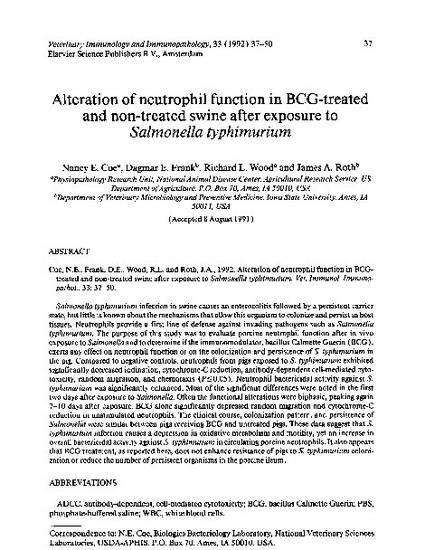
Article
Alteration of Neutrophil Function in BCG-Treated and Non-Treated Swine after Exposure to Salmonella typhimurium
Veterinary Immunology and Immunopathology
Document Type
Article
Disciplines
Publication Version
Published Version
Publication Date
6-1-1992
DOI
10.1016/0165-2427(92)90033-M
Abstract
Salmonella typhimurium infection in swine causes an enterocolitis followed by a persistent carrier state, but little is known about the mechanisms that allow this organism to colonize and persist in host tissues. Neutrophils provide a first line of defense against invading pathogens such as Salmonella typhimurium. The purpose of this study was to evaluate porcine neutrophil function after in vivo exposure to Salmonella and to determine if the immunomodulator, bacillus Calmette Guerin (BCG), exerts any effect on neutrophil function or on the colonization and persistence of S. typhimurium in the pig. Compared to negative controls, neutrophils from pigs exposed to S. typhimurium exhibited significantly decreased iodination, cytochrome-C reduction, antibody-dependent cell-mediated cytotoxicity, random migration, and chemotaxis (P≤0.05). Neutrophil bactericidal activity against S. typhimurium was significantly enhanced. Most of the significant differences were noted in the first two days after exposure to Salmonella. Often the functional alterations were biphasic, peaking again 7–10 days after exposure. BCG alone significantly depressed random migration and cytochrome-C reduction in unstimulated neutrophils. The clinical course, colonization pattern, and persistence of Salmonella were similar between pigs receiving BCG and untreated pigs. These data suggest that S. typhimurium infection causes a depression in oxidative metabolism and motility, yet an increase in overall bactericidal activity against S. typhimurium in circulating porcine neutrophils. It also appears that BCG treatment, as reported here, does not enhance resistance of pigs to S. typhimurium colonization or reduce the number of persistent organisms in the porcine ileum.
Rights
Works produced by employees of the U.S. Government as part of their official duties are not copyrighted within the U.S. The content of this document is not copyrighted.
Language
en
File Format
application/pdf
Citation Information
Nancy Ellen Coe, Dagmar E. Frank, Richard L. Wood and James A. Roth. "Alteration of Neutrophil Function in BCG-Treated and Non-Treated Swine after Exposure to Salmonella typhimurium" Veterinary Immunology and Immunopathology Vol. 33 Iss. 1-2 (1992) p. 37 - 50 Available at: http://works.bepress.com/james_roth/18/

This article is from Veterinary Immunology and Immunopathology 33 (1992): 37.